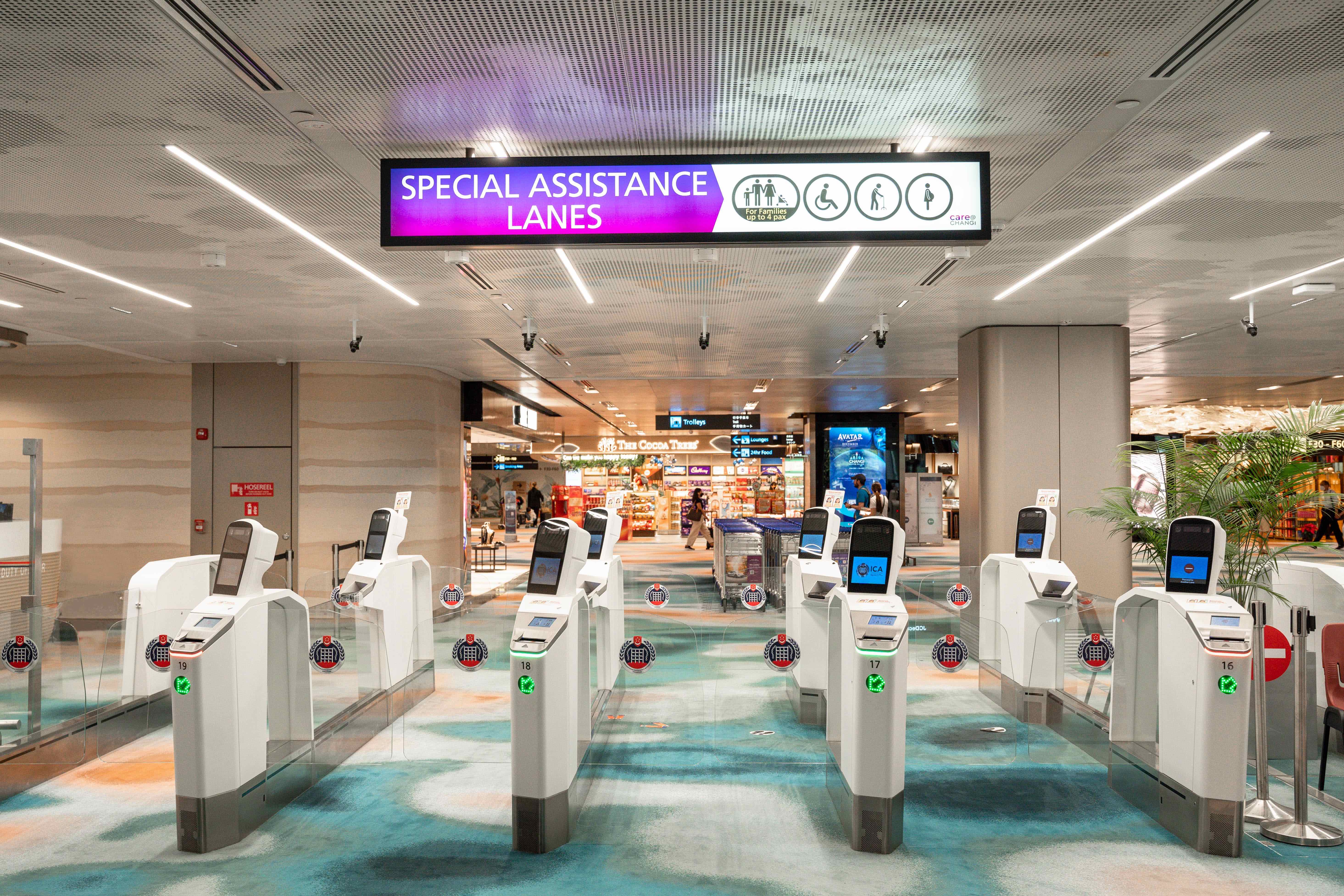Listen up, folks. The world is moving faster than ever before, and so is the way we handle immigration. Automated immigration systems are no longer just a futuristic concept—they're here, and they're changing the game. Imagine walking through customs without the usual hassle, where technology does the heavy lifting for you. Sounds too good to be true? Think again. These systems are designed to streamline the process, making it smoother, safer, and more efficient for everyone involved. So, buckle up, because we're diving deep into how this tech marvel is transforming global travel as we know it.
Now, before we dive headfirst into the nitty-gritty, let's talk about why this matters. Every year, millions of people cross borders for work, study, or leisure. The traditional immigration process? It's clunky, time-consuming, and often filled with unnecessary delays. But here's the kicker: automated immigration systems are stepping in to fix all that. They're using cutting-edge tech like biometrics, AI, and machine learning to make things run like clockwork. It's not just about convenience—it's about security, accuracy, and efficiency.
So, whether you're a frequent traveler, an immigration officer, or just someone curious about how the future of global mobility is shaping up, this article is for you. We'll break down everything you need to know about automated immigration systems, from how they work to their benefits, challenges, and what the future holds. Let's get started!
- Roland Garros Schedules Your Ultimate Guide To The French Open
- Unlocking The Secrets Of Lister Crawler The Ultimate Guide
Table of Contents
- What is an Automated Immigration System?
- How Does Automated Immigration System Work?
- Biography of Automated Immigration Systems
- Benefits of Automated Immigration Systems
- Challenges Faced by Automated Immigration Systems
- Security Measures in Automated Immigration Systems
- Global Impact of Automated Immigration Systems
- The Future of Automated Immigration Systems
- Traditional vs. Automated Immigration Systems
- Conclusion: Embracing the Future of Immigration
What is an Automated Immigration System?
Let's start with the basics. An automated immigration system (AIS) is essentially a tech-driven solution designed to simplify and enhance the immigration process. It uses advanced technologies like facial recognition, fingerprint scanning, and AI algorithms to verify identities and process travelers more efficiently. Think of it as a digital gatekeeper that ensures only authorized individuals pass through while keeping security threats at bay.
These systems are being implemented in airports, seaports, and land borders around the world. They're not just about speeding things up; they're also about improving accuracy and reducing the risk of human error. With AIS, immigration officers can focus on more critical tasks, while the technology handles the routine checks. It's a win-win for everyone involved.
How Does Automated Immigration System Work?
Step-by-Step Process
Alright, so you're probably wondering, "How exactly does this magic happen?" Well, let's break it down step by step. When you approach an automated immigration checkpoint, here's what typically happens:
- My Chart Uihc The Ultimate Guide To Understanding And Maximizing Your Healthcare Experience
- Renee Estevez The Rising Star In Hollywood You Need To Know About
- Biometric Scanning: Your face, fingerprints, or iris is scanned to verify your identity against the data stored in the system.
- Data Matching: The system cross-references your biometric data with the information in your passport or travel documents.
- Risk Assessment: Advanced algorithms analyze your travel history and other relevant data to assess any potential risks.
- Approval or Denial: If everything checks out, you're cleared to proceed. If not, the system flags you for further review by immigration officials.
It's all about speed, accuracy, and security. And the best part? It's all done in a matter of seconds.
Biography of Automated Immigration Systems
Now, let's take a trip down memory lane and see how these systems came to be. The concept of automated immigration systems isn't new. It's been in the works for decades, with early versions relying on basic biometric data like fingerprints. But as technology advanced, so did the systems. Today, we have sophisticated platforms that integrate multiple layers of security and user-friendly interfaces.
Here's a quick rundown of the key milestones:
- 1980s: The first biometric systems were introduced, focusing primarily on fingerprint scanning.
- 2000s: Facial recognition technology started gaining traction, paving the way for more comprehensive systems.
- 2010s: AI and machine learning began to play a significant role, enhancing the accuracy and efficiency of automated systems.
- 2020s: The current systems are smarter, faster, and more secure than ever before.
And here's a quick glance at some key data:
| Year | Technology | Key Features |
|---|---|---|
| 1980s | Fingerprint Scanning | Basic identity verification |
| 2000s | Facial Recognition | Improved accuracy |
| 2010s | AI & Machine Learning | Advanced risk assessment |
| 2020s | Integrated Platforms | Seamless user experience |
Benefits of Automated Immigration Systems
Why AIS is a Game-Changer
There are plenty of reasons why automated immigration systems are worth the hype. Here are some of the top benefits:
- Increased Efficiency: Travelers can pass through immigration checkpoints faster, reducing wait times and improving the overall travel experience.
- Enhanced Security: Advanced biometric technologies make it harder for unauthorized individuals to slip through the cracks.
- Cost-Effective: By automating routine tasks, governments can save money on staffing and resources.
- Improved Accuracy: AI-driven systems minimize the risk of human error, ensuring more reliable results.
It's not just about convenience; it's about creating a safer, more efficient global travel ecosystem.
Challenges Faced by Automated Immigration Systems
Of course, no system is perfect. While automated immigration systems offer countless advantages, they also come with their fair share of challenges. Here are some of the main issues:
- Privacy Concerns: Collecting and storing biometric data raises questions about data protection and privacy.
- Technical Glitches: Like any technology, AIS can experience malfunctions, leading to delays and frustration.
- Implementation Costs: Setting up these systems can be expensive, especially for smaller countries or regions.
- Public Trust: Convincing people to trust a machine with their personal information can be a tough sell.
But hey, every challenge is an opportunity in disguise. Governments and tech companies are working hard to address these issues and make AIS even better.
Security Measures in Automated Immigration Systems
Security is at the heart of every automated immigration system. These platforms are designed with multiple layers of protection to ensure that sensitive data is kept safe. Here are some of the key security measures in place:
- Encryption: All data is encrypted to prevent unauthorized access.
- Access Control: Only authorized personnel can access the system and its data.
- Regular Audits: Systems are routinely audited to identify and address any vulnerabilities.
- Compliance Standards: AIS platforms adhere to international standards for data protection and privacy.
With these measures in place, governments can be confident that their automated immigration systems are as secure as possible.
Global Impact of Automated Immigration Systems
How AIS is Changing the World
The impact of automated immigration systems extends far beyond individual travelers. They're reshaping the global travel landscape in ways we're only beginning to understand. Here are a few examples:
- Boosting Tourism: Faster and easier immigration processes encourage more people to travel, benefiting local economies.
- Enhancing Trade: By streamlining border crossings, AIS makes it easier for goods and services to move across borders.
- Improving Diplomatic Relations: Efficient immigration systems can foster better relationships between countries.
It's not just about technology; it's about creating a more connected and prosperous world.
The Future of Automated Immigration Systems
So, where do we go from here? The future of automated immigration systems looks bright. As technology continues to evolve, we can expect even more advanced features and capabilities. Here are a few trends to watch for:
- Blockchain Integration: Using blockchain to enhance data security and transparency.
- AI-Powered Predictive Analytics: Leveraging AI to predict and prevent potential security threats.
- Seamless Travel Experiences: Creating a truly seamless journey from booking to destination.
The possibilities are endless, and the impact could be game-changing.
Traditional vs. Automated Immigration Systems
Let's compare the old way of doing things with the new. Traditional immigration systems rely heavily on manual processes, which can be slow, error-prone, and less secure. On the other hand, automated systems offer:
- Speed: Faster processing times
- Accuracy: Reduced human error
- Security: Advanced biometric and AI technologies
It's clear that AIS is the way forward, offering a more efficient and secure alternative to traditional methods.
Conclusion: Embracing the Future of Immigration
There you have it, folks. Automated immigration systems are here to stay, and they're changing the game in ways we couldn't have imagined just a few years ago. From streamlining travel to enhancing security, these systems are making global mobility easier, safer, and more efficient for everyone involved.
So, what can you do? If you're a traveler, familiarize yourself with the systems in place at your destination. If you're a policymaker or industry professional, consider how AIS can benefit your organization. And if you're just someone interested in the future of travel, stay curious and keep learning.
And hey, don't forget to share this article with your friends and family. The more people know about automated immigration systems, the better equipped we'll all be to navigate the future of global travel. Let's embrace the change and make the most of it!



Detail Author:
- Name : Prof. Jaylin Goldner
- Username : fweber
- Email : jocelyn.dooley@gmail.com
- Birthdate : 1997-02-23
- Address : 77584 McKenzie Isle Jadynmouth, MI 69862
- Phone : +1 (951) 496-2199
- Company : King, Nikolaus and Smitham
- Job : Travel Agent
- Bio : Est aliquid tempora aut ipsam. Asperiores quam aut est dolor. Voluptatum enim vitae accusamus pariatur dolor nesciunt et. Illum voluptas ipsa beatae dignissimos earum.
Socials
instagram:
- url : https://instagram.com/raheem5297
- username : raheem5297
- bio : Itaque dolores ut deleniti sit. Quidem maxime incidunt est nisi facilis.
- followers : 486
- following : 1859
twitter:
- url : https://twitter.com/raheem8023
- username : raheem8023
- bio : Provident aut quisquam qui quis suscipit. Vel maiores rerum ut sunt ducimus.
- followers : 530
- following : 676